Identification of Ecological Risk “Source-Sink” Landscape Functions of Resource-Based Region: A Case Study in Liaoning Province, China
Abstract
:1. Introduction
2. Materials and Methods
2.1. Study Area
2.2. Data Source
2.3. Methods
2.3.1. Classification of Ecological Risk “Source-Sink” Landscapes
2.3.2. Calculation of Ecological Risk “Source-Sink” Landscape Functions
2.3.3. Calculation of Modified Ecological Risk “Source-Sink” Landscape Functions
2.3.4. Calculation of Multiple Ecological Risk “Source-Sink” Landscape Functions
3. Results
3.1. Different Ecological Risk “Source-Sink” Landscape Functions
3.2. Multiple Ecological Risk “Source-Sink” Landscape Functions
4. Discussion
4.1. Drivers of Ecological Risk
4.1.1. Analysis of the Results of Multiple Ecological Risk “Source-Sink” Landscape Functions and Ecological Risk Assessment
4.1.2. Driving Analysis of Human Activity Factors for Ecological Risk
4.2. Regulation Strategy Combining Ecological Risks and Ecological Risk Assessment
4.3. Limitation and Future Work
5. Conclusions
Supplementary Materials
Author Contributions
Funding
Data Availability Statement
Conflicts of Interest
References
- Rothacker, L.; Dosseto, A.; Francke, A.; Chivas, A.R.; Vigier, N.; Kotarba-Morley, A.M.; Menozzi, D. Impact of Climate Change and Human Activity on Soil Landscapes over the Past 12,300 Years. Sci. Rep. 2018, 8, 247. [Google Scholar] [CrossRef]
- Niacsu, L.; Bucur, D.; Ionita, I.; Codru, I.-C. Soil Conservation Measures on Degraded Land in the Hilly Region of Eastern Romania: A Case Study from Puriceni-Bahnari Catchment. Water 2022, 14, 525. [Google Scholar] [CrossRef]
- Xu, Y.; Tang, T.; Sun, G. Research on Planning Evaluation Index System of Residential Areas in Mountainous City for Geological Disaster Prevention—A Case. Disaster Adv. 2013, 6, 114–121. [Google Scholar]
- Calo, F.; Calcaterra, D.; Iodice, A.; Parise, M.; Ramondini, M. Assessing the Activity of a Large Landslide in Southern Italy by Ground-Monitoring and SAR Interferometric Techniques. Int. J. Remote Sens. 2012, 33, 3512–3530. [Google Scholar] [CrossRef]
- Kairis, O.; Kosmas, C.; Karavitis, C.; Ritsema, C.; Salvati, L.; Acikalin, S.; Alcala, M.; Alfama, P.; Atlhopheng, J.; Barrera, J.; et al. Evaluation and Selection of Indicators for Land Degradation and Desertification Monitoring: Types of Degradation, Causes, and Implications for Management. Environ. Manag. 2014, 54, 971–982. [Google Scholar] [CrossRef] [PubMed]
- Wijitkosum, S. Reducing Vulnerability to Desertification by Using the Spatial Measures in a Degraded Area in Thailand. Land 2020, 9, 49. [Google Scholar] [CrossRef]
- Carlsen, T.M.; Coty, J.D.; Kercher, J.R. The Spatial Extent of Contaminants and the Landscape Scale: An Analysis of the Wildlife, Conservation Biology, and Population Modeling Literature. Environ. Toxicol. Chem. Int. J. 2004, 23, 798–811. [Google Scholar] [CrossRef] [PubMed]
- Chen, S.; Zhang, Q.; Andrews-Speed, P.; Mclellan, B. Quantitative Assessment of the Environmental Risks of Geothermal Energy: A Review. J. Environ. Manag. 2020, 276, 111287. [Google Scholar] [CrossRef] [PubMed]
- Hope, B.K. An Examination of Ecological Risk Assessment and Management Practices. Environ. Int. 2006, 32, 983–995. [Google Scholar] [CrossRef] [PubMed]
- Schmolke, A.; Thorbek, P.; Chapman, P.; Grimm, V. Ecological Models and Pesticide Risk Assessment: Current Modeling Practice. Environ. Toxicol. Chem. Int. J. 2010, 29, 1006–1012. [Google Scholar] [CrossRef]
- Tixier, G.; Lafont, M.; Grapentine, L.; Rochfort, Q.; Marsalek, J. Ecological Risk Assessment of Urban Stormwater Ponds: Literature Review and Proposal of a New Conceptual Approach Providing Ecological Quality Goals and the Associated Bioassessment Tools. Ecol. Indic. 2011, 11, 1497–1506. [Google Scholar] [CrossRef]
- Tullos, D.; Byron, E.; Galloway, G.; Obeysekera, J.; Prakash, O.; Sun, Y.-H. Review of Challenges of and Practices for Sustainable Management of Mountain Flood Hazards. Nat. Hazards 2016, 83, 1763–1797. [Google Scholar] [CrossRef]
- Landis, W.G. Twenty Years before and Hence; Ecological Risk Assessment at Multiple Scales with Multiple Stressors and Multiple Endpoints. Hum. Ecol. Risk Assess. Int. J. 2003, 9, 1317–1326. [Google Scholar] [CrossRef]
- Kayumba, P.M.; Chen, Y.; Mind’je, R.; Mindje, M.; Li, X.; Maniraho, A.P.; Umugwaneza, A.; Uwamahoro, S. Geospatial Land Surface-Based Thermal Scenarios for Wetland Ecological Risk Assessment and Its Landscape Dynamics Simulation in Bayanbulak Wetland, Northwestern China. Landsc. Ecol. 2021, 36, 1699–1723. [Google Scholar] [CrossRef]
- Liu, Y.; Liu, Y.; Li, J.; Lu, W.; Wei, X.; Sun, C. Evolution of Landscape Ecological Risk at the Optimal Scale: A Case Study of the Open Coastal Wetlands in Jiangsu, China. Int. J. Environ. Res. Public Health 2018, 15, 1691. [Google Scholar] [CrossRef]
- Luo, F.; Liu, Y.; Peng, J.; Wu, J. Assessing Urban Landscape Ecological Risk through an Adaptive Cycle Framework. Landsc. Urban Plan. 2018, 180, 125–134. [Google Scholar] [CrossRef]
- Peng, J.; Zong, M.; Hu, Y.; Liu, Y.; Wu, J. Assessing Landscape Ecological Risk in a Mining City: A Case Study in Liaoyuan City, China. Sustainability 2015, 7, 8312–8334. [Google Scholar] [CrossRef]
- Liu, S.; Wang, D.; Lei, G.; Li, H.; Li, W. Elevated Risk of Ecological Land and Underlying Factors Associated with Rapid Urbanization and Overprotected Agriculture in Northeast China. Sustainability 2019, 11, 6203. [Google Scholar] [CrossRef]
- Wu, J.; Zhu, Q.; Qiao, N.; Wang, Z.; Sha, W.; Luo, K.; Wang, H.; Feng, Z. Ecological Risk Assessment of Coal Mine Area Based on “Source-Sink” Landscape Theory—A Case Study of Pingshuo Mining Area. J. Clean. Prod. 2021, 295, 126371. [Google Scholar] [CrossRef]
- Xu, W.; Wang, J.; Zhang, M.; Li, S. Construction of Landscape Ecological Network Based on Landscape Ecological Risk Assessment in a Large-Scale Opencast Coal Mine Area. J. Clean. Prod. 2021, 286, 125523. [Google Scholar] [CrossRef]
- Lin, Y.; Hu, X.; Zheng, X.; Hou, X.; Zhang, Z.; Zhou, X.; Qiu, R.; Lin, J. Spatial Variations in the Relationships between Road Network and Landscape Ecological Risks in the Highest Forest Coverage Region of China. Ecol. Indic. 2019, 96, 392–403. [Google Scholar] [CrossRef]
- Ju, H.; Niu, C.; Zhang, S.; Jiang, W.; Zhang, Z.; Zhang, X.; Yang, Z.; Cui, Y. Spatiotemporal Patterns and Modifiable Areal Unit Problems of the Landscape Ecological Risk in Coastal Areas: A Case Study of the Shandong Peninsula, China. J. Clean. Prod. 2021, 310, 127522. [Google Scholar] [CrossRef]
- Cui, L.; Zhao, Y.; Liu, J.; Han, L.; Ao, Y.; Yin, S. Landscape Ecological Risk Assessment in Qinling Mountain. Geol. J. 2018, 53, 342–351. [Google Scholar] [CrossRef]
- Kapustka, L.A.; Bowers, K.; Isanhart, J.; Martinez-Garza, C.; Finger, S.; Stahl, R.G., Jr.; Stauber, J. Coordinating Ecological Restoration Options Analysis and Risk Assessment to Improve Environmental Outcomes. Integr. Environ. Assess. Manag. 2016, 12, 253–263. [Google Scholar] [CrossRef] [PubMed]
- Liu, Y.; Peng, J.; Zhang, T.; Zhao, M. Assessing Landscape Eco-Risk Associated with Hilly Construction Land Exploitation in the Southwest of China: Trade-off and Adaptation. Ecol. Indic. 2016, 62, 289–297. [Google Scholar] [CrossRef]
- Huang, N.; Lin, T.; Guan, J.; Zhang, G.; Qin, X.; Liao, J.; Liu, Q.; Huang, Y. Identification and Regulation of Critical Source Areas of Non-Point Source Pollution in Medium and Small Watersheds Based on Source-Sink Theory. Land 2021, 10, 668. [Google Scholar] [CrossRef]
- Rudra, R.P.; Mekonnen, B.A.; Shukla, R.; Shrestha, N.K.; Goel, P.K.; Daggupati, P.; Biswas, A. Currents Status, Challenges, and Future Directions in Identifying Critical Source Areas for Non-Point Source Pollution in Canadian Conditions. Agriculture 2020, 10, 468. [Google Scholar] [CrossRef]
- Sun, R.; Xie, W.; Chen, L. A Landscape Connectivity Model to Quantify Contributions of Heat Sources and Sinks in Urban Regions. Landsc. Urban Plan. 2018, 178, 43–50. [Google Scholar] [CrossRef]
- Huang, D.; Zhu, S.; Liu, T. Are There Differences in the Forces Driving the Conversion of Different Non-Urban Lands into Urban Use? A Case Study of Beijing. Environ. Sci. Pollut. Res. 2022, 29, 6414–6432. [Google Scholar] [CrossRef]
- Li, S.; Zhao, Y.; Xiao, W.; Yue, W.; Wu, T. Optimizing Ecological Security Pattern in the Coal Resource-Based City: A Case Study in Shuozhou City, China. Ecol. Indic. 2021, 130, 108026. [Google Scholar] [CrossRef]
- Jiang, M.; Chen, H.; Chen, Q. A Method to Analyze “Source-Sink” Structure of Non-Point Source Pollution Based on Remote Sensing Technology. Environ. Pollut. 2013, 182, 135–140. [Google Scholar] [CrossRef] [PubMed]
- Zhang, X.; Cui, J.; Liu, Y.; Wang, L. Geo-Cognitive Computing Method for Identifying “Source-Sink” Landscape Patterns of River Basin Non-Point Source Pollution. Int. J. Agric. Biol. Eng. 2017, 10, 55–68. [Google Scholar] [CrossRef]
- Li, S.; Xiao, W.; Zhao, Y.; Lv, X. Incorporating Ecological Risk Index in the Multi-Process MCRE Model to Optimize the Ecological Security Pattern in a Semi-Arid Area with Intensive Coal Mining: A Case Study in Northern China. J. Clean. Prod. 2020, 247, 119143. [Google Scholar] [CrossRef]
- Peng, J.; Hu, X.; Qiu, S.; Meersmans, J.; Liu, Y. Multifunctional Landscapes Identification and Associated Development Zoning in Mountainous Area. Sci. Total Environ. 2019, 660, 765–775. [Google Scholar] [CrossRef]
- Qiu, S.; Yu, Q.; Niu, T.; Fang, M.; Guo, H.; Liu, H.; Li, S.; Zhang, J. Restoration and Renewal of Ecological Spatial Network in Mining Cities for the Purpose of Enhancing Carbon Sinks: The Case of Xuzhou, China. Ecol. Indic. 2022, 143, 109313. [Google Scholar] [CrossRef]
- Li, W.; Wang, D.; Liu, S.; Zhu, Y. Measuring Urbanization-Occupation and Internal Conversion of Peri-Urban Cultivated Land to Determine Changes in the Peri-Urban Agriculture of the Black Soil Region. Ecol. Indic. 2019, 102, 328–337. [Google Scholar] [CrossRef]
- Wu, Z.; Lei, S.; Lu, Q.; Bian, Z. Impacts of Large-Scale Open-Pit Coal Base on the Landscape Ecological Health of Semi-Arid Grasslands. Remote Sens. 2019, 11, 1820. [Google Scholar] [CrossRef]
- Chen, X.; Xu, D.; Fadelelseed, S.; Li, L. Spatiotemporal Analysis and Control of Landscape Eco-Security at the Urban Fringe in Shrinking Resource Cities: A Case Study in Daqing, China. Int. J. Environ. Res. Public Health 2019, 16, 4640. [Google Scholar] [CrossRef] [PubMed]
- Jia, Y.; Tang, X.; Liu, W. Spatial–Temporal Evolution and Correlation Analysis of Ecosystem Service Value and Landscape Ecological Risk in Wuhu City. Sustainability 2020, 12, 2803. [Google Scholar] [CrossRef]
- Xu, Y.; Yang, B.; Liu, G.; Liu, P. Topographic Differentiation Simulation of Crop Yield and Soil and Water Loss on the Loess Plateau. J. Geogr. Sci. 2009, 19, 331–339. [Google Scholar] [CrossRef]
- de Oro, L.A.; Colazo, J.C.; Buschiazzo, D.E. RWEQ–Wind Erosion Predictions for Variable Soil Roughness Conditions. Aeolian Res. 2016, 20, 139–146. [Google Scholar] [CrossRef]
- Pi, H.; Sharratt, B.; Feng, G.; Lei, J. Evaluation of Two Empirical Wind Erosion Models in Arid and Semi-Arid Regions of China and the USA. Environ. Model. Softw. 2017, 91, 28–46. [Google Scholar] [CrossRef]
- Wang, W.; Samat, A.; Ge, Y.; Ma, L.; Tuheti, A.; Zou, S.; Abuduwaili, J. Quantitative Soil Wind Erosion Potential Mapping for Central Asia Using the Google Earth Engine Platform. Remote Sens. 2020, 12, 3430. [Google Scholar] [CrossRef]
- Li, D.; Xu, E.; Zhang, H. Bidirectional Coupling between Land-Use Change and Desertification in Arid Areas: A Study Contrasting Intracoupling and Telecoupling. Land Degrad. Dev. 2022, 33, 221–234. [Google Scholar] [CrossRef]
- Ge, X.; Ni, J.; Li, Z.; Hu, R.; Ming, X.; Ye, Q. Quantifying the Synergistic Effect of the Precipitation and Land Use on Sandy Desertification at County Level: A Case Study in Naiman Banner, Northern China. J. Environ. Manag. 2013, 123, 34–41. [Google Scholar]
- Ying, B.; Xiao, S.; Xiong, K.; Cheng, Q.; Luo, J. Comparative Studies of the Distribution Characteristics of Rocky Desertification and Land Use/Land Cover Classes in Typical Areas of Guizhou Province, China. Environ. Earth Sci. 2014, 71, 631–645. [Google Scholar] [CrossRef]
- You, H. Orienting Rocky Desertification towards Sustainable Land Use: An Advanced Remote Sensing Tool to Guide the Conservation Policy. Land Use Policy 2017, 61, 171–184. [Google Scholar] [CrossRef]
- Yu, W.; Yao, X.; Shao, L.; Liu, J.; Shen, Y.; Zhang, H. Classification of Desertification on the North Bank of Qinghai Lake. Comput. Mater. Contin. 2022, 72, 695–711. [Google Scholar] [CrossRef]
- Wu, Z.; Wang, M.; Zhang, H.; Du, Z. Vegetation and Soil Wind Erosion Dynamics of Sandstorm Control Programs in the Agro-Pastoral Transitional Zone of Northern China. Front. Earth Sci. 2019, 13, 430–443. [Google Scholar] [CrossRef]
- Yan, Y.; Xu, X.; Xin, X.; Yang, G.; Wang, X.; Yan, R.; Chen, B. Effect of Vegetation Coverage on Aeolian Dust Accumulation in a Semiarid Steppe of Northern China. Catena 2011, 87, 351–356. [Google Scholar] [CrossRef]
- Bullock, A.; King, B. Evaluating China’s Slope Land Conversion Program as Sustainable Management in Tianquan and Wuqi Counties. J. Environ. Manag. 2011, 92, 1916–1922. [Google Scholar] [CrossRef]
- Wang, J.; Liu, Y.; Liu, Z. Spatio-Temporal Patterns of Cropland Conversion in Response to the “Grain for Green Project” in China’s Loess Hilly Region of Yanchuan County. Remote Sens. 2013, 5, 5642–5661. [Google Scholar] [CrossRef]
- Du, H.; Dou, S.; Deng, X.; Xue, X.; Wang, T. Assessment of Wind and Water Erosion Risk in the Watershed of the Ningxia-Inner Mongolia Reach of the Yellow River, China. Ecol. Indic. 2016, 67, 117–131. [Google Scholar] [CrossRef]
- Zhang, Z.; Luo, J.; Chen, B. Spatially Explicit Quantification of Total Soil Erosion by RTK GPS in Wind and Water Eroded Croplands. Sci. Total Environ. 2020, 702, 134716. [Google Scholar] [CrossRef]
- Li, J.; Ma, X.; Zhang, C. Predicting the Spatiotemporal Variation in Soil Wind Erosion across Central Asia in Response to Climate Change in the 21st Century. Sci. Total Environ. 2020, 709, 136060. [Google Scholar] [CrossRef]
- Liang, H.; Yian, M.; Qian, J.; Zhang, H.; Song, J. Soil Wind Erosion Characteristics and Influence Factors in Ningxia Based on Wind Erosion Model. Res. Soil Water Conserv. 2019, 26, 34–40. [Google Scholar]
- Chi, W.F.; Kuang, W.H.; Jia, J.; Liu, Z.J. Study on Dynamic Remote Sensing Monitoring of LUCC and Soilwind Erosion Intensity in the Beijing-Tianjin Sandstorm Source Control Project Region. Remote Sens. Technol. Appl. 2019, 33, 965–974. [Google Scholar]
- Ikemi, H. Geologically Constrained Changes to Landforms Caused by Human Activities in the 20th Century: A Case Study from Fukuoka Prefecture, Japan. Appl. Geogr. 2017, 87, 115–126. [Google Scholar] [CrossRef]
- Lin, J.; Lin, M.; Chen, W.; Zhang, A.; Qi, X.; Hou, H. Ecological Risks of Geological Disasters and the Patterns of the Urban Agglomeration in the Fujian Delta Region. Ecol. Indic. 2021, 125, 107475. [Google Scholar] [CrossRef]
- Zhao, Y.; Xu, X.; He, T.; Li, Y.; Hu, J. Changes of Land Use and Environment in Underground Coal Mining Area in China. Disaster Adv. 2013, 6, 125–131. [Google Scholar]
- Mo, W.; Wang, Y.; Zhang, Y.; Zhuang, D. Impacts of Road Network Expansion on Landscape Ecological Risk in a Megacity, China: A Case Study of Beijing. Sci. Total Environ. 2017, 574, 1000–1011. [Google Scholar] [CrossRef] [PubMed]
- Donjadee, S.; Tingsanchali, T. Reduction of Runoff and Soil Loss over Steep Slopes by Using Vetiver Hedgerow Systems. Paddy Water Environ. 2013, 11, 573–581. [Google Scholar] [CrossRef]
- Jiang, Z.; Huete, A.R.; Didan, K.; Miura, T. Development of a Two-Band Enhanced Vegetation Index without a Blue Band. Remote Sens. Environ. 2008, 112, 3833–3845. [Google Scholar] [CrossRef]
- Wang, X.-D.; Zhong, X.-H.; Fan, J.-R. Spatial Distribution of Soil Erosion Sensitivity on the Tibet Plateau. Pedosphere 2005, 15, 465–472. [Google Scholar]
- Zhang, R.; Liu, X.; Heathman, G.C.; Yao, X.; Hu, X.; Zhang, G. Assessment of Soil Erosion Sensitivity and Analysis of Sensitivity Factors in the Tongbai–Dabie Mountainous Area of China. Catena 2013, 101, 92–98. [Google Scholar] [CrossRef]
- Wu, L.; Liu, X.; Ma, X. Spatiotemporal Distribution of Rainfall Erosivity in the Yanhe River Watershed of Hilly and Gully Region, Chinese Loess Plateau. Environ. Earth Sci. 2016, 75, 315. [Google Scholar] [CrossRef]
- Meng, M.; Ni, J.; Zhang, Z.-G. Aridity Index and Its Applications in Geo-Ecological Study. Chin. J. Plant Ecol. 2004, 28, 853. [Google Scholar]
- Wang, Y.L. The Summae Concerning Arid Meteorological Targets to Establish, Quote and Test in China. Arid Land Geogr 1990, 3, 80–86. [Google Scholar]
- Zhang, C.H.; Wang, M.J.; Li, X.H.; Guo, R.; Zhang, L.W. The Characteristics of Temporal and Spatial Distribution of Climate Dry-Wet Conditions over Inner Mongolia in Recent 30 Years. J. Arid Land Resour. Environ. 2011, 25, 70–75. [Google Scholar]
- Mandakh, N.; Tsogtbaatar, J.; Dash, D.; Khudulmur, S. Spatial Assessment of Soil Wind Erosion Using WEQ Approach in Mongolia. J. Geogr. Sci. 2016, 26, 473–483. [Google Scholar] [CrossRef]
- Zhou, Y.; Guo, B.; Wang, S.; Tao, H. An Estimation Method of Soil Wind Erosion in Inner Mongolia of China Based on Geographic Information System and Remote Sensing. J. Arid Land 2015, 7, 304–317. [Google Scholar] [CrossRef]
- Menegaki, M.E.; Kaliampakos, D.C. Evaluating Mining Landscape: A Step Forward. Ecol. Eng. 2012, 43, 26–33. [Google Scholar] [CrossRef]
- Marzen, M.; Iserloh, T.; Casper, M.C.; Ries, J.B. Quantification of Particle Detachment by Rain Splash and Wind-Driven Rain Splash. Catena 2015, 127, 135–141. [Google Scholar] [CrossRef]
- Zhang, F.; Wang, J.; Zou, X.; Mao, R.; Gong, D.; Feng, X. Wind Erosion Climate Change in Northern China During 1981–2016. Int. J. Disaster Risk Sci. 2020, 11, 484–496. [Google Scholar] [CrossRef]
- Qing, H.E.; XingHua, Y.; Ali Mamtimin, S.T. Impact Factors of Soil Wind Erosion in the Center of Taklimakan Desert. J. Arid Land 2011, 3, 9–14. [Google Scholar] [CrossRef]
- Zhan, J.; Shi, N.; He, S.; Lin, Y. Factors and Mechanism Driving the Land-Use Conversion in Jiangxi Province. J. Geogr. Sci. 2010, 20, 525–539. [Google Scholar] [CrossRef]
- Zhou, Y.; Li, X.; Liu, Y. Land Use Change and Driving Factors in Rural China during the Period 1995-2015. Land Use Policy 2020, 99, 105048. [Google Scholar] [CrossRef]
- Wu, Z.; Lei, S.; He, B.-J.; Bian, Z.; Wang, Y.; Lu, Q.; Peng, S.; Duo, L. Assessment of Landscape Ecological Health: A Case Study of a Mining City in a Semi-Arid Steppe. Int. J. Environ. Res. Public Health 2019, 16, 752. [Google Scholar] [CrossRef] [PubMed]
- Guo, L.; Liu, R.; Men, C.; Wang, Q.; Miao, Y.; Shoaib, M.; Wang, Y.; Jiao, L.; Zhang, Y. Multiscale Spatiotemporal Characteristics of Landscape Patterns, Hotspots, and Influencing Factors for Soil Erosion. Sci. Total Environ. 2021, 779, 146474. [Google Scholar] [CrossRef] [PubMed]
- Opdam, P.; Steingröver, E.; Van Rooij, S. Ecological Networks: A Spatial Concept for Multi-Actor Planning of Sustainable Landscapes. Landsc. Urban Plan. 2006, 75, 322–332. [Google Scholar] [CrossRef]
- Sandström, U.G.; Angelstam, P.; Khakee, A. Urban Comprehensive Planning–Identifying Barriers for the Maintenance of Functional Habitat Networks. Landsc. Urban Plan. 2006, 75, 43–57. [Google Scholar] [CrossRef]
- Cao, Q.; Zhang, X.; Lei, D.; Guo, L.; Sun, X.; Wu, J. Multi-Scenario Simulation of Landscape Ecological Risk Probability to Facilitate Different Decision-Making Preferences. J. Clean. Prod. 2019, 227, 325–335. [Google Scholar] [CrossRef]
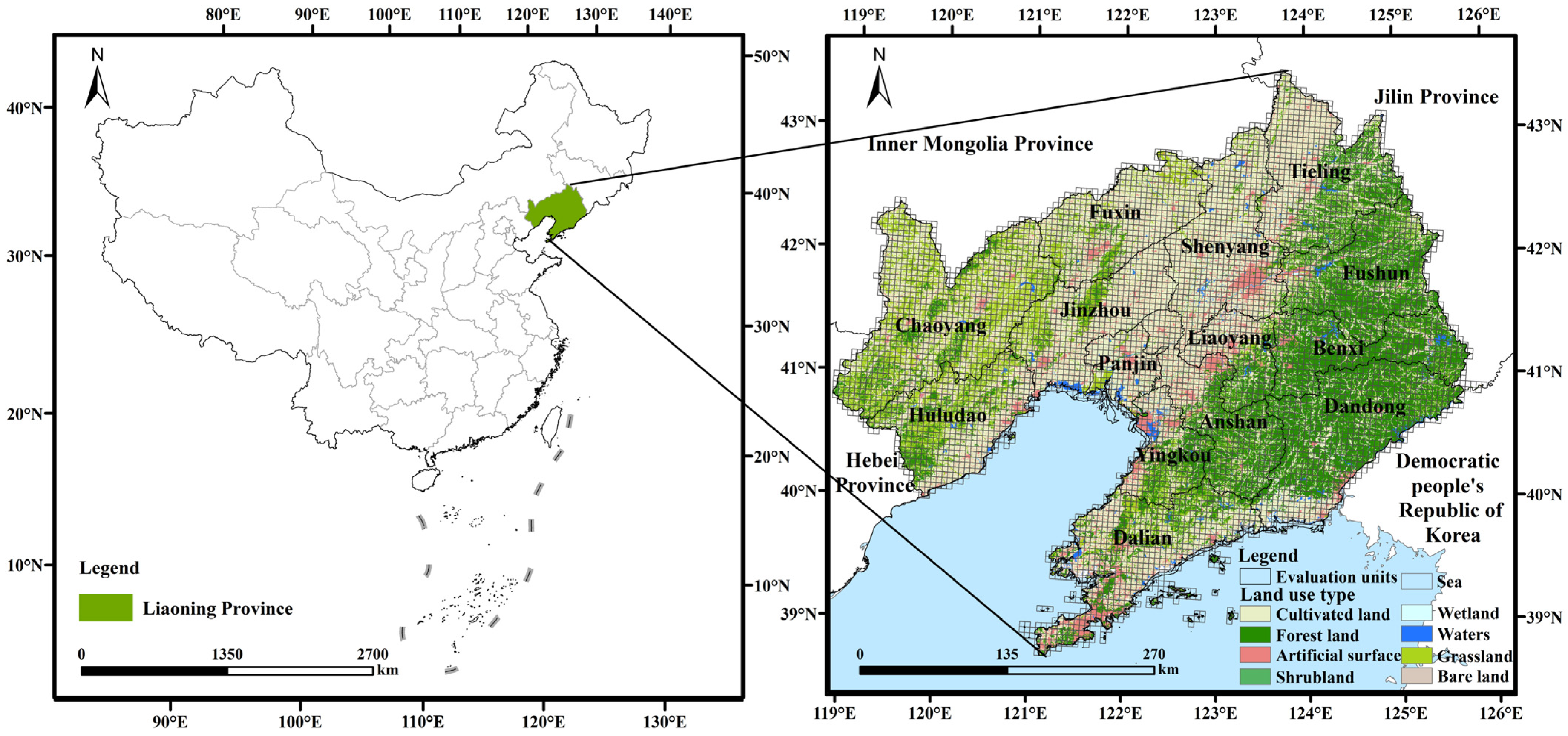
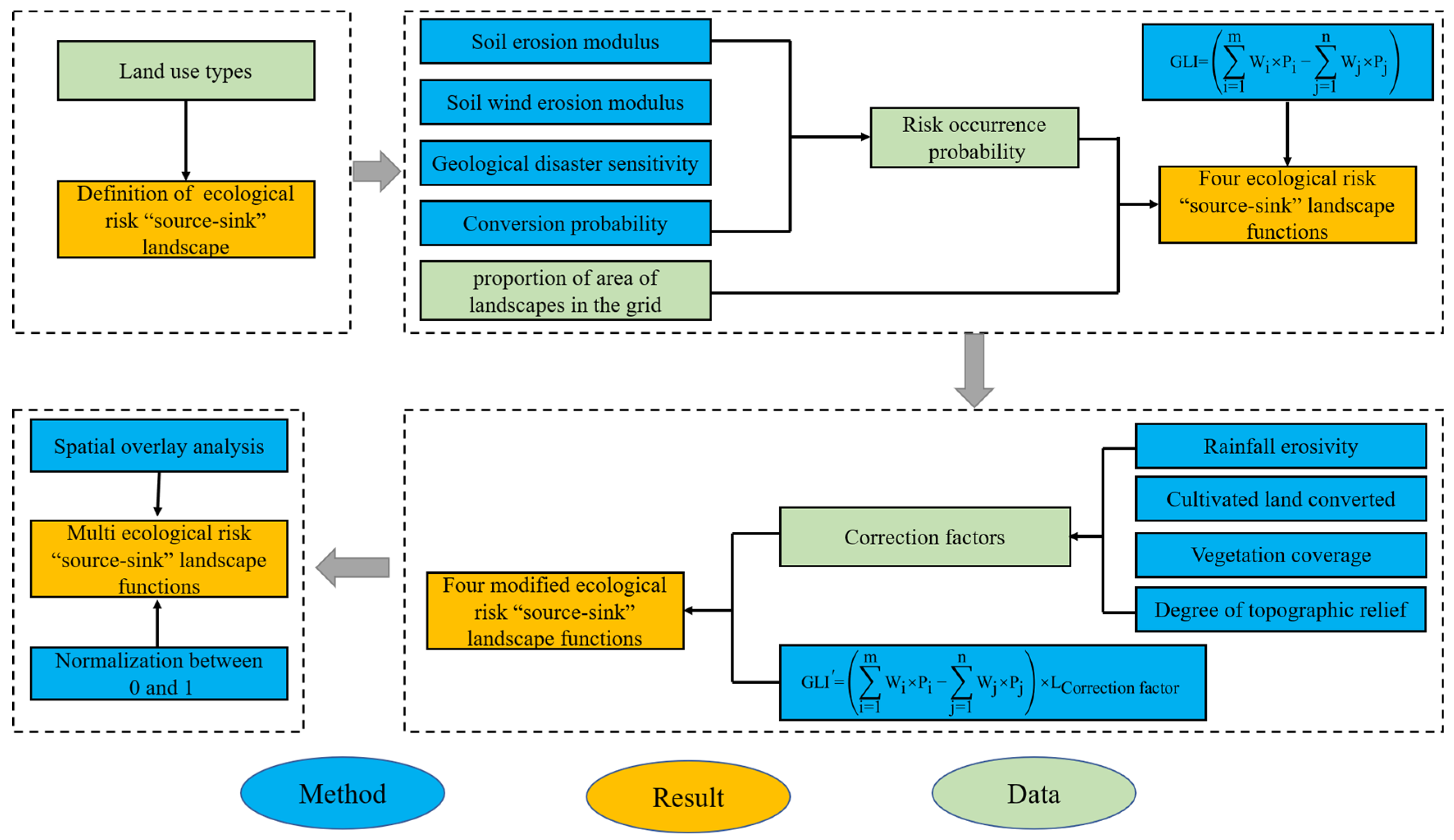
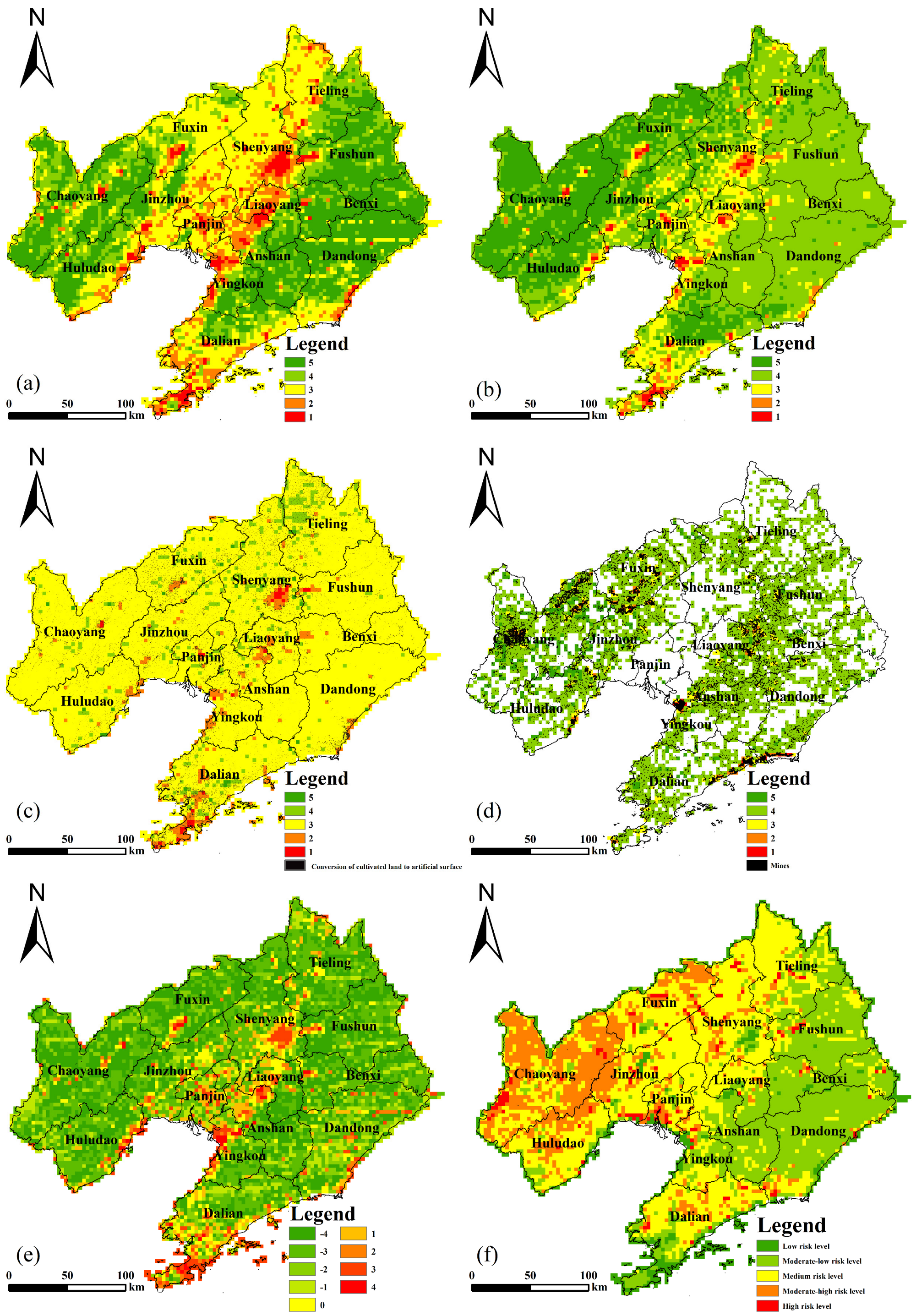
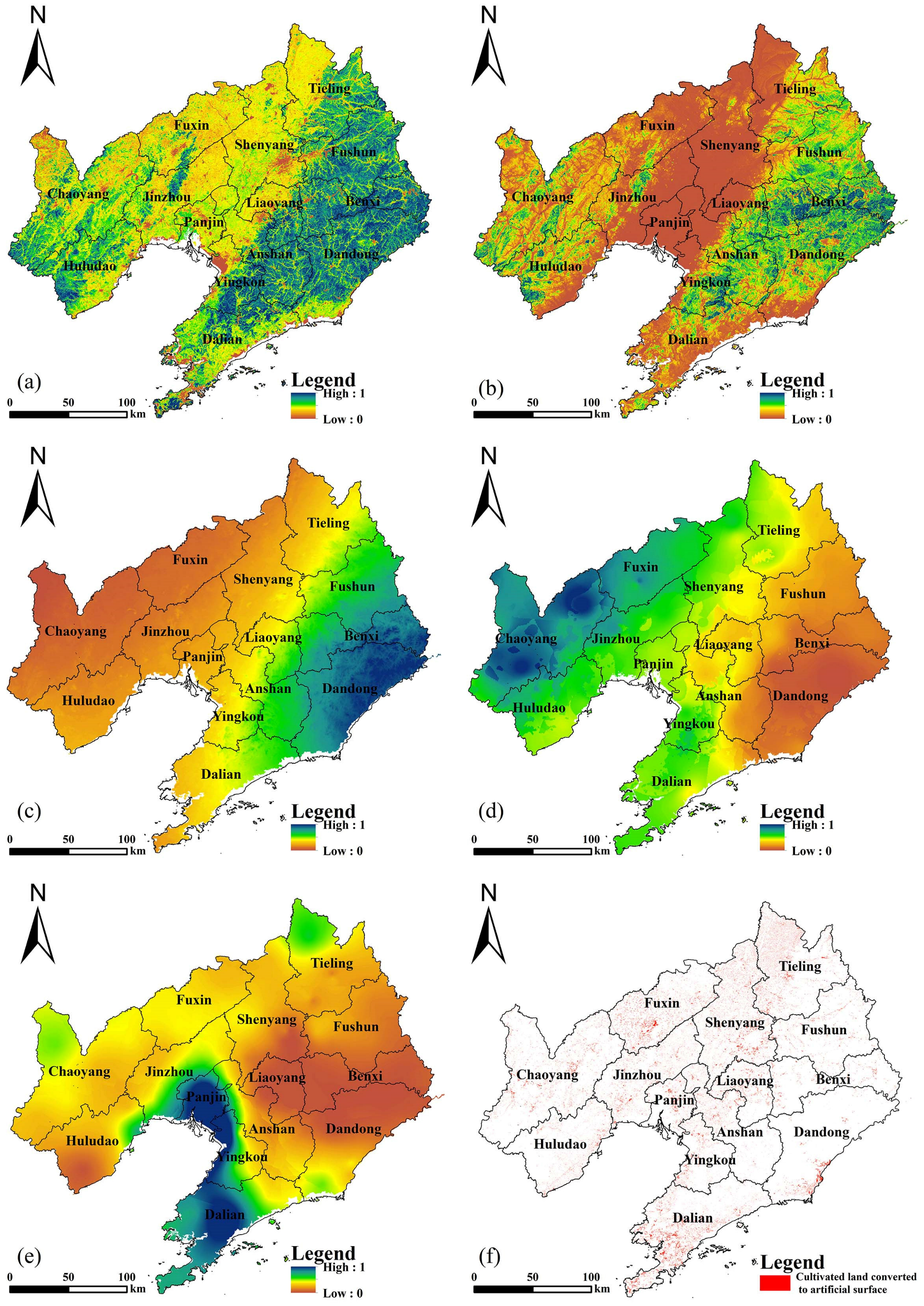

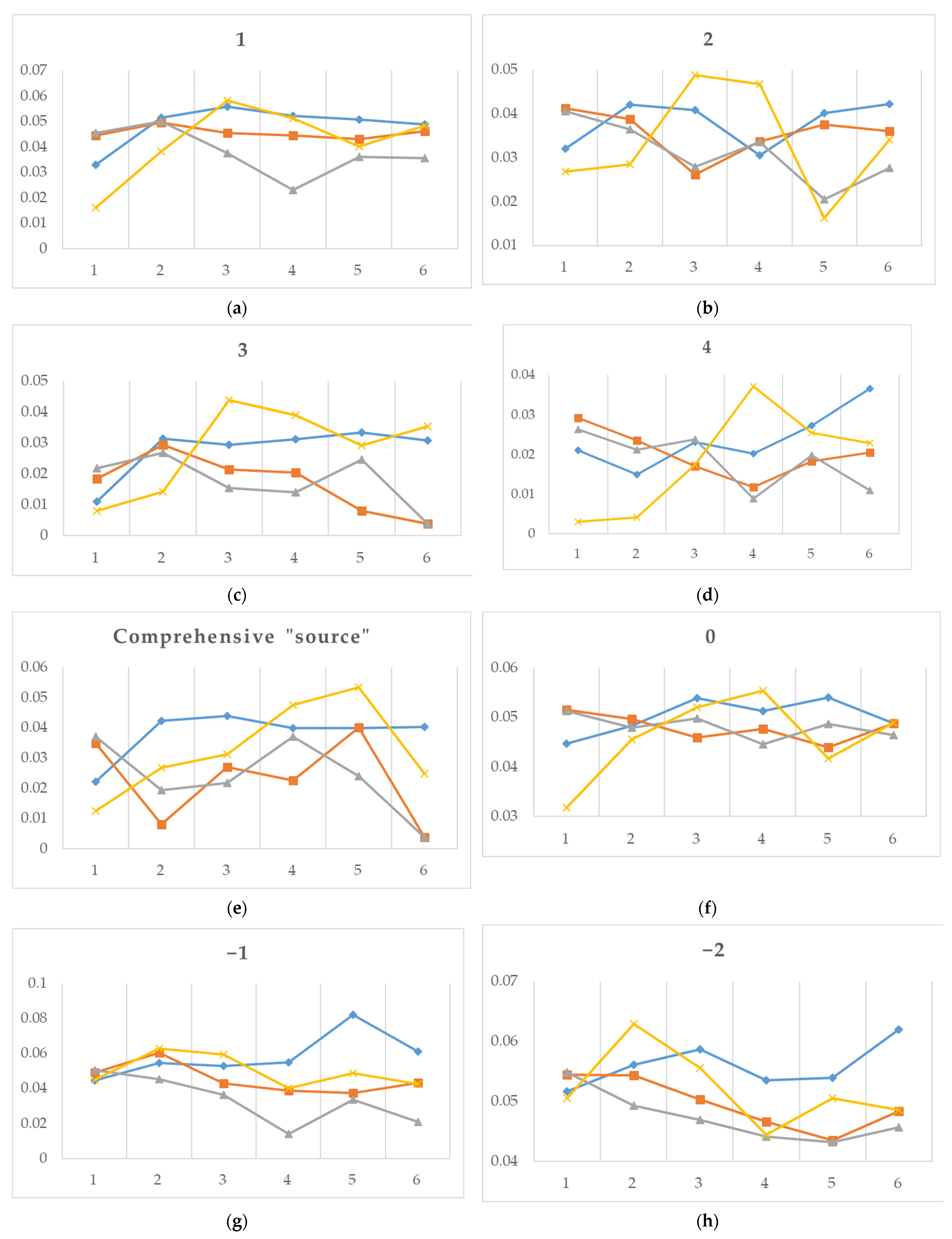

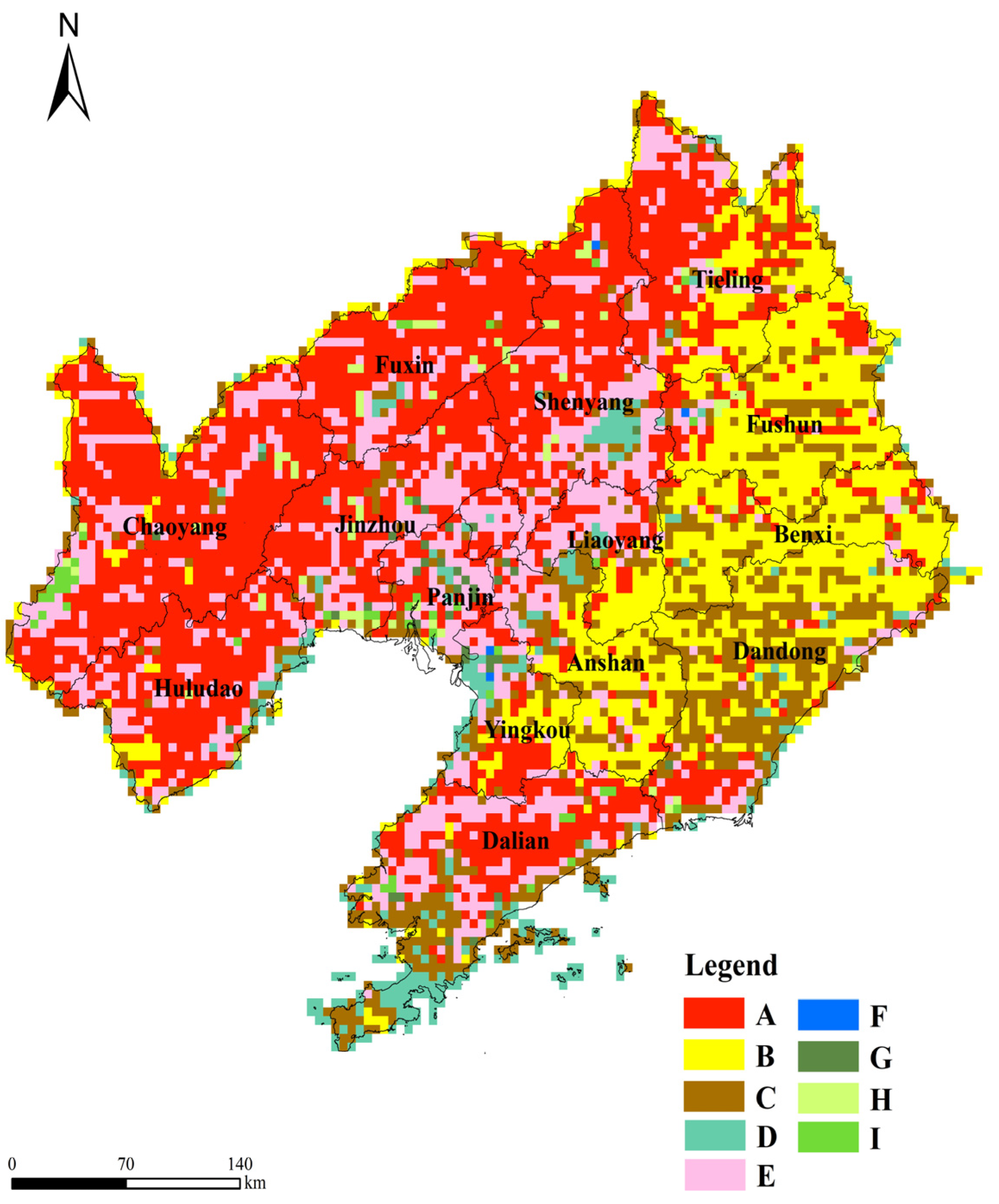
| Data | Format | Source |
|---|---|---|
| Land use (2010–2020) | Grids at 30 m resolution in 2010 and 2020 | GlobeLand30 |
| SRTMDEM | Grids at 90 m resolution | Geospatial Data Cloud (China) |
| Precipitation (2020) | Points in 2020 | China Meteorological Data Service Center (China) |
| Temperature (2020) | ||
| Wind speed (2020) | ||
| Normalized difference vegetation index | Grids at 250 m resolution in 2020 | NASA’s 16-day L3 Global 250 m product (MOD13Q1) |
| Mining area | Vector | Department of Natural Resources of Liaoning Province |
| Landscape Type | Slope | ||||
|---|---|---|---|---|---|
| Min | Max | Mean | Cells of Cultivated Land of Slope ≥ 25° | Total Cells of Cultivated Land | |
| Cultivated land | 0 | 49.48761 | 3.61649 | 29,026 | 8,243,237 |
| Landscape Type | FVC | |||||
|---|---|---|---|---|---|---|
| Min | Max | Mean | Cells of Landscapes of FVC ≤ 0.2 | Total Cells of Landscapes | Percentage (%) | |
| Cultivated land | 0 | 1 | 0.45 | 21,563 | 8,243,237 | 0.26 |
| Forest | 0 | 1 | 0.82 | 2401 | 5,406,440 | 0.04 |
| Grassland | 0 | 1 | 0.62 | 7643 | 2,578,060 | 0.29 |
| Shrubland | 0.09343 | 1 | 0.63 | 4 | 2189 | 0.18 |
| Multiple Ecological Risk “Source-Sink” Landscape Function | Number of Grids | Percentage of Total Grids (%) |
|---|---|---|
| “Source” landscape function | 806 | 12.8 |
| “Sink” landscape function | 5146 | 81.6 |
| Neither of all | 355 | 5.6 |
| 1 | 2 | 3 | 4 | Comeprehensive “Source” | 0 | |
|---|---|---|---|---|---|---|
| Density of road network | 0.1692 | 0.0756 | 0.1862 | 0.0455 | 0.1452 | 0.0285 |
| GDP | 0.0124 | 0.1066 | 0.0446 | 0.0435 | 0.0599 | 0.0061 |
| Population density | 0.0165 | 0.0632 | 0.0391 | 0.0389 | 0.0656 | 0.0059 |
| Land use type converted to artificial surface | 0.4789 | 0.3307 | 0.3492 | 0.2085 | 0.4506 | 0.1384 |
| −1 | −2 | −3 | −4 | Comprehensive “Sink” | ||
| Density of road network | 0.0851 | 0.0175 | 0.0059 | 0.0039 | 0.0086 | |
| GDP | 0.0209 | 0.0041 | 0.0075 | 0.0043 | 0.00306 | |
| Population density | 0.0079 | 0.0069 | 0.0001 | 0.0016 | 0.00301 | |
| Land use type converted to artificial surface | 0.0976 | 0.0559 | 0.0753 | 0.0864 | 0.07874 | |
Disclaimer/Publisher’s Note: The statements, opinions and data contained in all publications are solely those of the individual author(s) and contributor(s) and not of MDPI and/or the editor(s). MDPI and/or the editor(s) disclaim responsibility for any injury to people or property resulting from any ideas, methods, instructions or products referred to in the content. |
© 2023 by the authors. Licensee MDPI, Basel, Switzerland. This article is an open access article distributed under the terms and conditions of the Creative Commons Attribution (CC BY) license (https://creativecommons.org/licenses/by/4.0/).
Share and Cite
Wang, S.; Zhao, Y.; Ren, H.; Zhu, S.; Yang, Y. Identification of Ecological Risk “Source-Sink” Landscape Functions of Resource-Based Region: A Case Study in Liaoning Province, China. Land 2023, 12, 1921. https://doi.org/10.3390/land12101921
Wang S, Zhao Y, Ren H, Zhu S, Yang Y. Identification of Ecological Risk “Source-Sink” Landscape Functions of Resource-Based Region: A Case Study in Liaoning Province, China. Land. 2023; 12(10):1921. https://doi.org/10.3390/land12101921
Chicago/Turabian StyleWang, Shaoqing, Yanling Zhao, He Ren, Shichao Zhu, and Yunhui Yang. 2023. "Identification of Ecological Risk “Source-Sink” Landscape Functions of Resource-Based Region: A Case Study in Liaoning Province, China" Land 12, no. 10: 1921. https://doi.org/10.3390/land12101921




